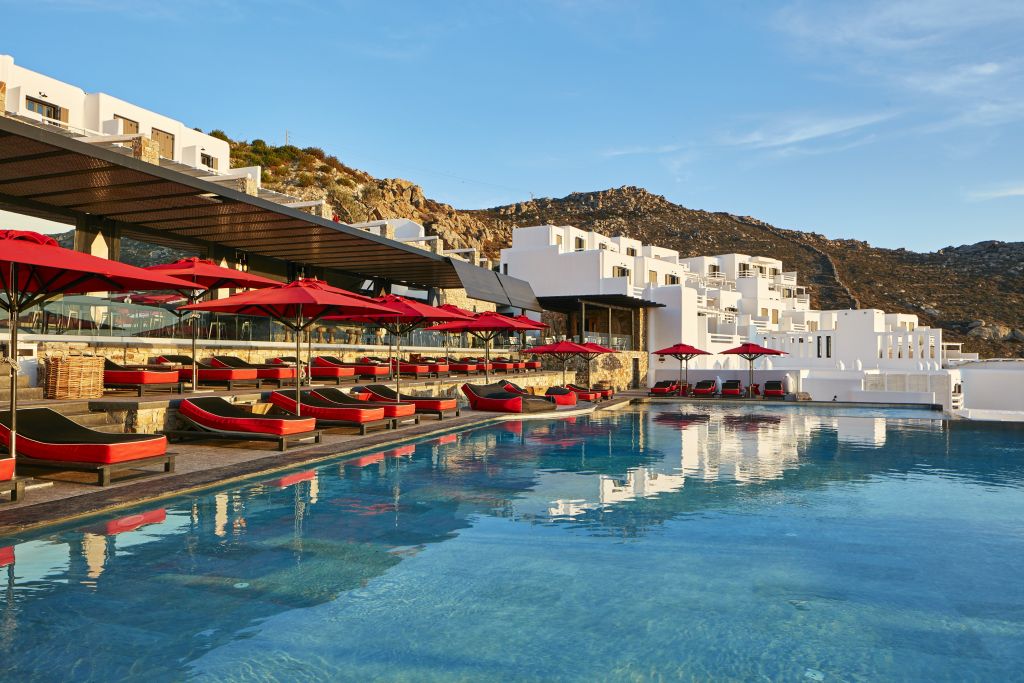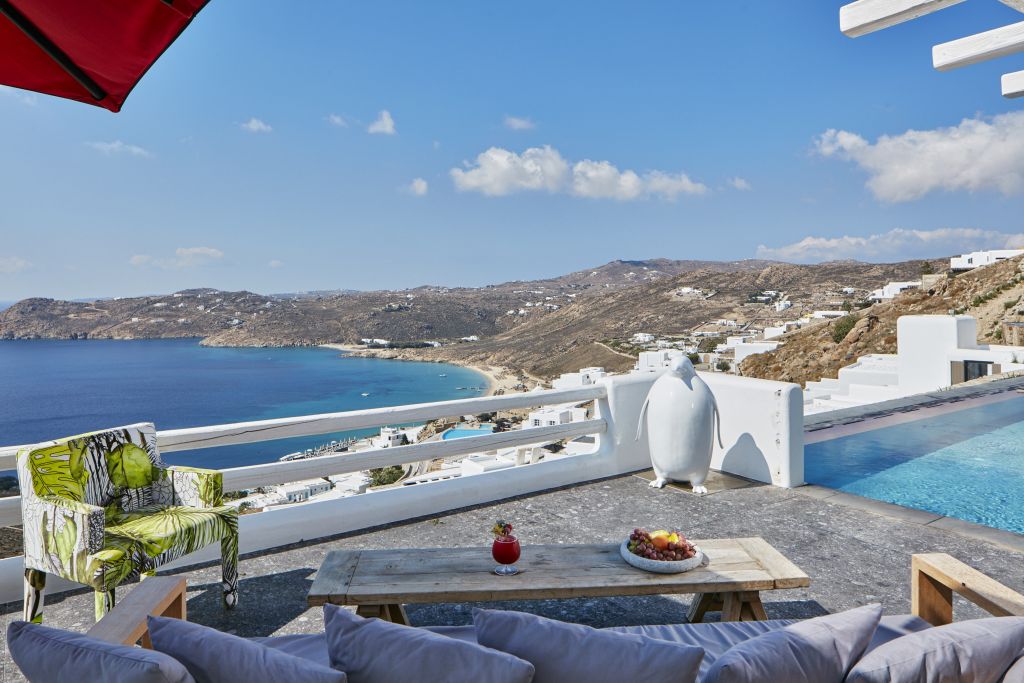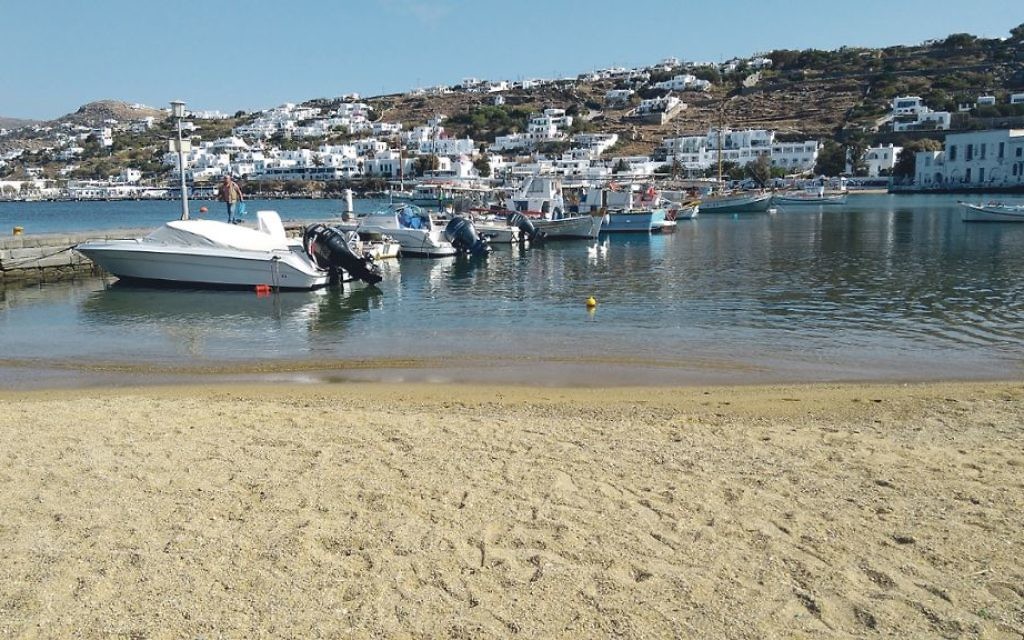The magic of Mykonos and the world’s oldest shul
Lucy Daltroff explores the stunning Greek island where Shirley Valentine was filmed and discovers the myths and mystery surrounding the world’s oldest synagogue in Delos
With its striking white buildings, blue skies and lingering sunsets, it’s no wonder that Mykonos was the destination chosen as the backdrop to the 1989 smash hit Shirley Valentine – or indeed that the island has sustained its lavish status, despite the recession in Greece, thanks to its reputation as a holiday hotspot.
Yael Morad, one of many Israelis staying at the five-star Myconian Avaton Resort, enthuses about this beautiful Greek island.
“There is nothing like this in Israel, it’s an easy journey and it makes a really lovely break,” she says.
Get The Jewish News Daily Edition by email and never miss our top stories Free Sign Up
To understand more about the island’s magic, I decided to take a stroll around the capital, Chora, one fine evening and walked past a series of bright white windmills overlooking the sea.
These are the famous landmarks, not only of Mykonos itself, but also the whole of the group of islands to which Mykonos belongs: the Cyclades. The mills were an important part of the economy as they used to grind cereals and provide bread to passing ships.
Continuing on, threading around many churches and smelling the sweet fragrance of the bougainvillea trees, I came upon an unexpected library and cultural centre open each evening until 11pm. It was donated by a local teacher and intellectual, who gave up his substantial house to host an extensive collection of music and books.

When I reached the centre of Chora, I was immediately swept along by the locals dancing in the narrow streets – a feat probably only possible during the low season – to join the general air of happiness.
The best place to end up for the evening is Little Venice, an area of brightly-coloured houses that lap the sea edge. During the 18th century, they belonged to the few prosperous merchants residing on Mykonos, but now the buildings have been turned into buzzing restaurants and cafés. The atmosphere is great and it’s a perfect place to sip a cocktail and watch one of the famous sunsets over the
Aegean Sea.
It’s not always been quite this cushy. During the 1950s, Mykonos ran a barter economy and was bare and poor. But all was transformed when Greek shipping magnate Aristotle Onassis and his uber-stylish wife, Jackie O, famously dropped anchor. Thereafter, the island became known as a mecca for the rich and famous.

One man in particular saw this trend and helped the island monetise its potential. George Daktylides, who operated the public transport system, went on to build the first hotel in 1979 and, within a few years, had opened the five-star Ambassador Relais & Châteaux.
He and his wife Eleftheria simultaneously made the decision to send their four sons to the finest International Hotel School in Lausanne, Switzerland. The result today is the Myconian Collection, run by the boys and comprising nine outstanding hotels, which together have changed the status of the whole island. Each one has its own design features, spas and special characteristics, making Mykonos one of the ritziest tourist spots in the world.

On day three of my stay, I tore myself away from the luxury and took the short two kilometres ferry ride to the island of Delos – one of the most important historical and archaeological locations in Greece and, understandably, a UNESCO World Heritage Site.
Only a select few archaeologists live there, and I was told in advance about the importance of wearing good walking shoes and taking a bottle of water, as there is very little shade.
As visitors are only allowed a maximum of four hours, remember to research in advance the times of return ferries. Then we were advised to turn off our phones and let the ferry transport us back in time.
Listen to the Jewish Views Podcast
The origins of Delos trace back to Greek mythology and, according to the tale, both Apollo and his twin sister, the goddess Artemis, were born here, rendering the precious island sacred. As a consequence, all pregnant mothers were sent by boat to give birth on a neighbouring island, but despite this inconvenience, by 100BC the community had grown to 30,000 people.
The Romans converted Delos into a free port attracting a multitude of traders and it became a hub of commercial, military, maritime trading and slaving. Our guide took us to see the huge amphitheatre where the community went to enjoy themselves, and then to some beautiful houses, complete with mosaic floors, where the prosperous merchants lived.
Finally, we viewed the famous Terrace of the Lions, the ancient statues that guarded the garden where Apollo and Artemis were said to have been born.
On the eastern side of the city, far away from the most important ruins, is what is thought to be oldest synagogue known in the world today. A team led by archaeologist André Plassart discovered the ruins in 1912 – the synagogue is believed to have remained in use until the end of the 2nd century AD. It consists of two large rooms containing a throne and multiple marble benches.
While there is disagreement between academics as to whether it is an actual synagogue or not, there is a certainty that Jews did at one time live and prosper here on this fascinating island.

Lucy’s travel tips:
Lucy stayed at the Myconian Avaton Resort, https://www.myconianavaton.gr , where rooms start from £225 per night. The hotel is part of the Myconian collection, myconiancollection.gr. For more information about Mykonos and Delos, go to visitgreece.gr/en

Thank you for helping to make Jewish News the leading source of news and opinion for the UK Jewish community. Today we're asking for your invaluable help to continue putting our community first in everything we do.
For as little as £5 a month you can help sustain the vital work we do in celebrating and standing up for Jewish life in Britain.
Jewish News holds our community together and keeps us connected. Like a synagogue, it’s where people turn to feel part of something bigger. It also proudly shows the rest of Britain the vibrancy and rich culture of modern Jewish life.
You can make a quick and easy one-off or monthly contribution of £5, £10, £20 or any other sum you’re comfortable with.
100% of your donation will help us continue celebrating our community, in all its dynamic diversity...
Engaging
Being a community platform means so much more than producing a newspaper and website. One of our proudest roles is media partnering with our invaluable charities to amplify the outstanding work they do to help us all.
Celebrating
There’s no shortage of oys in the world but Jewish News takes every opportunity to celebrate the joys too, through projects like Night of Heroes, 40 Under 40 and other compelling countdowns that make the community kvell with pride.
Pioneering
In the first collaboration between media outlets from different faiths, Jewish News worked with British Muslim TV and Church Times to produce a list of young activists leading the way on interfaith understanding.
Campaigning
Royal Mail issued a stamp honouring Holocaust hero Sir Nicholas Winton after a Jewish News campaign attracted more than 100,000 backers. Jewish Newsalso produces special editions of the paper highlighting pressing issues including mental health and Holocaust remembrance.
Easy access
In an age when news is readily accessible, Jewish News provides high-quality content free online and offline, removing any financial barriers to connecting people.
Voice of our community to wider society
The Jewish News team regularly appears on TV, radio and on the pages of the national press to comment on stories about the Jewish community. Easy access to the paper on the streets of London also means Jewish News provides an invaluable window into the community for the country at large.
We hope you agree all this is worth preserving.
-
By Brigit Grant
-
By Laurent Vaughan - Senior Associate (Bishop & Sewell Solicitors)
-
By Laurent Vaughan - Senior Associate (Bishop & Sewell Solicitors)
-
By Laurent Vaughan - Senior Associate (Bishop & Sewell Solicitors)
-
By Laurent Vaughan - Senior Associate (Bishop & Sewell Solicitors)






















